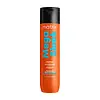What's inside
What's inside
 Key Ingredients
Key Ingredients

 Benefits
Benefits

 Concerns
Concerns

 Ingredients Side-by-side
Ingredients Side-by-side

Water
Skin ConditioningCetearyl Alcohol
EmollientBehentrimonium Chloride
PreservativeElaeis Guineensis Oil
EmollientIsopropyl Alcohol
SolventGlycerin
HumectantParfum
MaskingMethylparaben
PreservativeStearamidopropyl Dimethylamine
EmulsifyingButyrospermum Parkii Butter
Skin ConditioningBHT
AntioxidantCitric Acid
BufferingChlorhexidine Dihydrochloride
AntimicrobialOleamide
2-Oleamido-1,3-Octadecanediol
Skin ConditioningWater
Skin ConditioningButylene Glycol
HumectantDimethicone
EmollientSorbitol
HumectantBehenyl Alcohol
EmollientStearyl Alcohol
EmollientBehentrimonium Chloride
PreservativeCetyl Alcohol
EmollientGlyceryl Oleate
EmollientCocos Nucifera Oil
MaskingMoringa Oleifera Seed Oil
EmollientAvena Sativa Peptide
Skin ConditioningLaurdimonium Hydroxypropyl Hydrolyzed Keratin
Skin ConditioningArginine Hcl
Skin ConditioningRosa Canina Fruit Oil
EmollientPhosphatidylcholine
EmulsifyingTocopherol
AntioxidantAminopropyl Dimethicone
Isopropyl Alcohol
SolventStearyl Dihydroxypropyldimonium Oligosaccharides
Steartrimonium Chloride
PreservativeOctyldodecanol
EmollientPropylene Glycol
HumectantArginine
MaskingCitric Acid
BufferingDipropylene Glycol
HumectantPEG-6 Methyl Ether Dimethicone
EmulsifyingC10-40 Isoalkylamidopropylethyldimonium Ethosulfate
PEG-90m
Emulsion StabilisingGlycerin
HumectantPhenoxyethanol
PreservativeSodium Hydroxide
BufferingCitronellol
PerfumingAlpha-Isomethyl Ionone
PerfumingParfum
MaskingWater, Butylene Glycol, Dimethicone, Sorbitol, Behenyl Alcohol, Stearyl Alcohol, Behentrimonium Chloride, Cetyl Alcohol, Glyceryl Oleate, Cocos Nucifera Oil, Moringa Oleifera Seed Oil, Avena Sativa Peptide, Laurdimonium Hydroxypropyl Hydrolyzed Keratin, Arginine Hcl, Rosa Canina Fruit Oil, Phosphatidylcholine, Tocopherol, Aminopropyl Dimethicone, Isopropyl Alcohol, Stearyl Dihydroxypropyldimonium Oligosaccharides, Steartrimonium Chloride, Octyldodecanol, Propylene Glycol, Arginine, Citric Acid, Dipropylene Glycol, PEG-6 Methyl Ether Dimethicone, C10-40 Isoalkylamidopropylethyldimonium Ethosulfate, PEG-90m, Glycerin, Phenoxyethanol, Sodium Hydroxide, Citronellol, Alpha-Isomethyl Ionone, Parfum
Ingredients Explained
These ingredients are found in both products.
Ingredients higher up in an ingredient list are typically present in a larger amount.
This ingredient is a preservative and often used for it's anti-static properties. You'll most likely see this ingredient in hair conditioners.
It does not cause irritation or sensitization in leave-on products at 1-5%.
Citric Acid is an alpha hydroxy acid (AHA) naturally found in citrus fruits like oranges, lemons, and limes.
Like other AHAs, citric acid can exfoliate skin by breaking down the bonds that hold dead skin cells together. This helps reveal smoother and brighter skin underneath.
However, this exfoliating effect only happens at high concentrations (20%) which can be hard to find in cosmetic products.
Due to this, citric acid is usually included in small amounts as a pH adjuster. This helps keep products slightly more acidic and compatible with skin's natural pH.
In skincare formulas, citric acid can:
While it can provide some skin benefits, research shows lactic acid and glycolic acid are generally more effective and less irritating exfoliants.
Most citric acid used in skincare today is made by fermenting sugars (usually from molasses). This synthetic version is identical to the natural citrus form but easier to stabilize and use in formulations.
Read more about some other popular AHA's here:
Learn more about Citric AcidGlycerin is already naturally found in your skin. It helps moisturize and protect your skin.
A study from 2016 found glycerin to be more effective as a humectant than AHAs and hyaluronic acid.
As a humectant, it helps the skin stay hydrated by pulling moisture to your skin. The low molecular weight of glycerin allows it to pull moisture into the deeper layers of your skin.
Hydrated skin improves your skin barrier; Your skin barrier helps protect against irritants and bacteria.
Glycerin has also been found to have antimicrobial and antiviral properties. Due to these properties, glycerin is often used in wound and burn treatments.
In cosmetics, glycerin is usually derived from plants such as soybean or palm. However, it can also be sourced from animals, such as tallow or animal fat.
This ingredient is organic, colorless, odorless, and non-toxic.
Glycerin is the name for this ingredient in American English. British English uses Glycerol/Glycerine.
Learn more about GlycerinIsopropyl Alcohol is more commonly known as rubbing alcohol. It is most commonly used as a solvent, meaning it helps other ingredients dissolve.
This ingredient is an astringent alcohol. Astringent alcohols may also irritate skin as they high amounts may strip away your skin's natural oils.
Other types of astringent alcohols include:
According to the National Rosacea Society based in the US, you should be mindful of products with these alcohols in the top half of ingredients.
Any type of sanitizing product will have high amounts of alcohol to help kill bacteria and viruses.
Learn more about Isopropyl AlcoholParfum is a catch-all term for an ingredient or more that is used to give a scent to products.
Also called "fragrance", this ingredient can be a blend of hundreds of chemicals or plant oils. This means every product with "fragrance" or "parfum" in the ingredients list is a different mixture.
For instance, Habanolide is a proprietary trade name for a specific aroma chemical. When used as a fragrance ingredient in cosmetics, most aroma chemicals fall under the broad labeling category of “FRAGRANCE” or “PARFUM” according to EU and US regulations.
The term 'parfum' or 'fragrance' is not regulated in many countries. In many cases, it is up to the brand to define this term.
For instance, many brands choose to label themselves as "fragrance-free" because they are not using synthetic fragrances. However, their products may still contain ingredients such as essential oils that are considered a fragrance by INCI standards.
One example is Calendula flower extract. Calendula is an essential oil that still imparts a scent or 'fragrance'.
Depending on the blend, the ingredients in the mixture can cause allergies and sensitivities on the skin. Some ingredients that are known EU allergens include linalool and citronellol.
Parfum can also be used to mask or cover an unpleasant scent.
The bottom line is: not all fragrances/parfum/ingredients are created equally. If you are worried about fragrances, we recommend taking a closer look at an ingredient. And of course, we always recommend speaking with a professional.
Learn more about ParfumWater. It's the most common cosmetic ingredient of all. You'll usually see it at the top of ingredient lists, meaning that it makes up the largest part of the product.
So why is it so popular? Water most often acts as a solvent - this means that it helps dissolve other ingredients into the formulation.
You'll also recognize water as that liquid we all need to stay alive. If you see this, drink a glass of water. Stay hydrated!
Learn more about Water